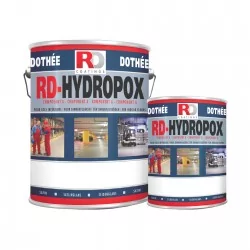How to repaint and protect the floor in your workshop or warehouse?
RD-Hydropox is a water-based floor coating, free from solvents and VOCs.
Whether applied on a new floor or during renovation, this coating is specifically designed to provide long-lasting protection for surfaces exposed to heavy wear and intense abrasion.
640x480.jpg)
640x430.jpg)
Products presented
RD-Hydropox Coating system for floors and walls specially formulated for the long-term protection against...
From €27.19 / Kg View
Coating system for floors and walls specially formulated for the long-term protection against...
The problem
Industrial floors in warehouses and workshops experience rapid wear due to heavy forklift traffic, abrasion, oils, greases, and aggressive chemicals. Without protection, the concrete slab deteriorates, crumbles, becomes porous and difficult to clean, compromising safety, durability, and the company’s image.
To prevent concrete from crumbling, it is essential to apply a high-performance coating resistant to wear, abrasion, and chemicals.
Unlike traditional solvent-based paints which are hazardous, inconvenient, and release toxic odors for a long time, RD Coatings offers a water-based solution: easy to apply, durable, solvent-free, and extremely resistant. Your floor regains a clean, safe, and professional appearance.
The solution
RD-Hydropox is a high-performance, water-based, two-component epoxy coating, designed to provide long-lasting protection for concrete, cement, ceramic floors, or even existing coatings.
Free from solvents and VOCs, it is perfectly suited for sensitive environments: no risk of fire or explosion, virtually odorless, and ideal for confined or occupied spaces.
Once applied, RD-Hydropox forms a satin film that is highly resistant to wear, impact, and intensive cleaning cycles.
For workshops with wet areas or damp floors, it can be combined with an aggregate to enhance its anti-slip properties and improve safety.
Thanks to its durability, chemical resistance, and formulation, RD-Hydropox is the preferred solution for the food industry, pharmaceuticals, and any sector requiring coatings compliant with hygiene standards (HACCP).
System(s)
RD-Hydropox is part of the ![]() - Single Coating System / One-Product System family developed by RD Coatings. It can be used both as a primer and as a topcoat.
- Single Coating System / One-Product System family developed by RD Coatings. It can be used both as a primer and as a topcoat.
We generally recommend applying at least two coats of RD-Hydropox. Using different colors between coats ensures a homogeneous application and sufficient coverage across the entire surface.
Theoretical consumption:
| Product | Consumption | Dry film | |||
| 1st layer | RD-Hydropox | 0,30 Kg/m² 190 s/f-g | 105 µ 4.2 mils | ||
| 2nd layer | RD-Hydropox | 0,30 Kg/m² 190 s/f-g | 105 µ 4.2 mils | ||
| /!\ The quantities indicated above are theoretical and do not take into account application losses or other factors such as substrate porosity. Always plan for a little extra product depending on the substrate and application method. | |||||
Enhancing anti-slip properties
- For floors that may become wet, it is recommended to use an aggregate such as quartz to provide anti-slip performance.
- Broadcast quartz in small amounts or to saturation onto the first wet coat of RD-Hydropox.
- Once the coat is dry, brush off the excess quartz.
- Then apply the second coat of RD-Hydropox.
More information on this topic can be found in our solution "Giving a floor anti-slip properties"
Application conditions and work preparation
Environmental conditions (general requirements):
- Minimum air and substrate temperature: 10°C / 50°F for 24 hours.
- Maximum surface temperature: 55°C / 130°F.
- Maximum relative humidity: 80 %.
- Surface temperature must be at least 3°C / 5°F above the dew point.
- No condensation should be present on the surface during application or drying.
- Not suitable for floors with rising damp.
- The moisture content in the screed must not exceed 4 %.
New screeds (< 4 cm): allow 1 week of drying per cm thickness.
Screeds > 4 cm: generally allow 2 weeks of drying per cm thickness.
Simple moisture test
Apply a transparent plastic film of 20x20 cm / 6x6 inches on the surface.
Seal the edges with tape to prevent air exchange.
Wait 24 to 48 hours.
If moisture droplets appear on the inside of the film:
- On an existing screed → presence of rising damp.
- On a new screed → not sufficiently dry yet.
Surface preparation
Before application, check that the cement or concrete screed is sound, cohesive, and strong enough to withstand future service conditions.
Previously painted screed (renovation)
- Check adhesion of the existing coating. Any unstable or poorly adhering paint must be removed.
- Recommended preparation:
- High-pressure cleaning (200–250 bar / 2900–3600 psi) with a rotary nozzle (0°) to remove oils, greases, and contaminants.
- Apply RD-Eco PowerClean, allow to act for 10–15 min.
- Rinse with a high-pressure washer.
- Allow to dry completely and vacuum.
This method removes contaminants and weakly adhering layers. Coatings that withstand this cleaning are generally suitable for overcoating.
👉 If the existing coating is epoxy or polyurethane, or if the surface is hard and smooth: perform mechanical sanding after cleaning to create roughness and optimize adhesion of RD-Hydropox.
New screed
- Remove laitance and surface additives by high-pressure cleaning, then allow to dry.
- For areas expecting heavy traffic: mechanical sanding is recommended to create a rough profile, improve mechanical adhesion, and eliminate laitance or residual hardener.
Chemical treatment (optional)
As an alternative to sanding, a diluted solution of phosphoric acid (5–15 %) may be used in the following cases:
- Smoothed or overly dense cement screeds (glassy, low-porosity surface).
- Presence of cement laitance on the surface.
- Areas where mechanical preparation is not possible (confined spaces, difficult access).
Application: spray the solution, allow ±15 minutes reaction time, then rinse thoroughly with clean water.
⚠️ Do not use on anhydrite screeds (calcium sulfate).
Tiled floors
Check the stability of tiles and joints.
- Re-fix loose tiles and redo joints if necessary.
- Remove fungi, moss, and mold using an approved fungicidal/moss treatment.
Surface preparation
- High-pressure cleaning to remove oils, greases, and contaminants.
- Apply RD-Eco PowerClean, allow to act for 10–15 min.
- Rinse with high-pressure washer.
- Allow to dry completely and vacuum.
Smooth and glossy tiles
Such surfaces may cause adhesion problems. In this case, perform a preliminary adhesion test. If necessary, sand the surface to create roughness and improve coating adhesion.
General requirement
The surface must always be clean, dry, grease-free, cohesive, and free of dust or any non-adhering contaminants.
Application material
RD-Hydropox
Brush, Floor paint roller, Airless (tip size: 021 – 023)
Tool cleaning
Only with clean water
Product application
RD-Hydropox
Ambient temperature : minimum 10°C (50°F) – optimum between 12 and 25°C (54–77°F).
Relative humidity : maximum 80 %
Dew point : > 3°C (5°F)
Moisture content in screed : must not exceed 4 %.
| Mixing ratio | RD-Hydropox | |
| By Weight | B : 140gr / A : 860gr | |
| By Volume | 4,8 : 1 | |
For optimal results, always use the full content of both supplied containers. Our products are available in kits of various sizes, designed to suit both small projects and large sites. Avoid manual on-site dosing: it always carries a risk of error that may compromise the final quality.
Pot life (A+B mixture) : 2 hours at 20°C (68°F).
Mixing
Mechanically mix components A and B for approx. 3 minutes (for 15 kg of product) until a homogeneous mass of uniform color is obtained.
After mixing, allow the product to rest for about 5 minutes to cool down and release air bubbles.
Drying times (at 20°C – 68°F)
Touch dry : after 8 hours
Overcoating :
- at 10°C (50°F) : minimum 24 hours, maximum 48 hours
- at 20°C (68°F) : minimum 12 hours, maximum 48 hours
- If the overcoating interval is exceeded, the first coat must be mechanically sanded to ensure optimal adhesion of the next coat.
- Final hardness : after 7 days
- RD-Hydropox requires approx. 3 days at 20°C (68°F) to reach maximum mechanical properties.
- Full chemical resistance is achieved after 7 days.
During this curing period, no liquid, including water, should come into contact with the coating.
VERS. S11-251025








